Celosia argentea var. plumosa for the Farmer Florist
A member of the Amaranthaceae family, the name celosia comes from the Greek keleous (“burning”), alluding to the flower’s brilliance. All ornamental forms of celosia are Celosia argentea var. cristata, which encompasses four groups: Cristata, the common cockscomb; Spicata, wheat celosia; Childsii, not common in horticultural circles; and Plumosa, Prince of Wales feather or plumed celosia. The Plumosa group is the second most common celosia behind the cockscomb. Available in a variety of flower colors and heights, they are known for their feathery (plumose) spike flowers.
Celosia argentea var. plumosa produces plumes full of feathery blooms on well-branched stems. The plumes range in height from 3 to 12 inches on 12- to 48-inch stems. They are exceptional as filler flowers but are also stunning as a focal point.
Production
Sow seed lightly in 288- to 50-cell plug trays 6–8 weeks before the last frost date. Place at 72–80˚F under mist. Light is required for germination, although the intensity can be very low, so supplemental lighting is not required. Seed will germinate in 8–14 days.
Transplanting plugs into the field on a successive schedule is recommended. Plant transplants in the field as soon as the threat of frost has passed, then plant successive crops every 3–4 weeks. Plants may be transplanted to a 6-by-6-inch spacing if grown as a single-harvest, single-stem crop. Plants may also be grown on 12-inch centers, 8-by-12-inch spacing, or even 18-inch spacing if plants are to be harvested continuously from a single planting.
Celosia will bloom from spring until late summer. However, it is a quantitative short-day plant, meaning that although it will flower at any photoperiod, it flowers faster under photoperiods of 14 hours or less. Flower initiation for celosia begins when the day length is short, preferably 12–13 hours. However, longer days allow for longer stem development. Inadequate day length can cause flower deformation or flat stems.
Pinching is not necessary for celosia but is highly recommended for cockscombs to increase branching and uniform flower size. When plants are 8–12 inches tall, pinch the stem with your thumb and index finger or use sterilized scissors to remove the growing point.
Pests and Diseases
The most common pests of celosia are aphids and thrips. High humidity and extended leaf wetness may increase the occurrence of disease. Improve air flow, use drip irrigation, and provide ample spacing to minimize disease pressure. Flowers in the Amaranth family are susceptible to powdery mildew, which can be identified by a white fungal growth with a powdery appearance on the leaves and occasionally flowers. Preventive fungicide applications may be recommended if conditions are right for fungal growth. The conditions that promote powdery mildew are also conducive to Alternaria leaf blight: warm, damp, and humid. Copper-containing fungicides are recommended.
Harvest and Postharvest
Celosia is an exceptional cut flower either used fresh or dried. For fresh use, harvest stems when the flowers are fully developed. Vase life for fresh-cut stems ranges from 5 days to 2 weeks depending on cultivar. Ideal storage temperature is 36–41˚F. Celosia are known to be sensitive to ethylene, so it is important to take note of other flowers stored in the same space. For use as dried flowers, harvest at the same stage of growth and remove all the foliage from the stem. Hang in a dark, well-ventilated location to dry.
Cultivar Recommendations
Celosia Century Series
Blooming season ranges from late spring through late summer. Specific characteristics of this series include heat tolerance, low maintenance, deer and rabbit resistance, and drought tolerance. Basal-branching plants produce 13-inch plumes. This series is suitable for greenhouse, field, or garden cut-flower production. Cultivars available in this series are Fire, Pink, Red, Rose, Salmon Pink, and Yellow.
Celosia Sunday Series
Attractive plumes in a wide color range make Sunday a novel textural addition to mixed bouquets. Striking flower form also makes this an eye-catching backyard cut flower. Works well under high tunnel or greenhouse production. Blooming season ranges from spring through autumn. The Sunday series has been shown to be heat-tolerant. Cultivars include Bright Pink Improved, Cherry, Cherry Improved, Dark Pink, Gold, Gold Improved, Green, and Orange.
Cut Flower Celosia Pampas Plume Series
Reaching heights of up to 48 inches, the Pampas Plume series is one of the fastest varieties to flower. These wispy plumes add lightness and texture to mixed bouquets. Cultivars in this series include Forest Fire, Golden, and Scarlet.
Design Applications
Plumed celosia is a prolific, easy-to-grow plant—so much so that we wonder why many consumers still find it exotic, exclaiming that they have never seen it before! With its wide color range, unique pattern and feathery texture, farmer florists should consider this plant for numerous bouquet combinations and floral designs.
Flowers to Wear and Carry
Boutonniere
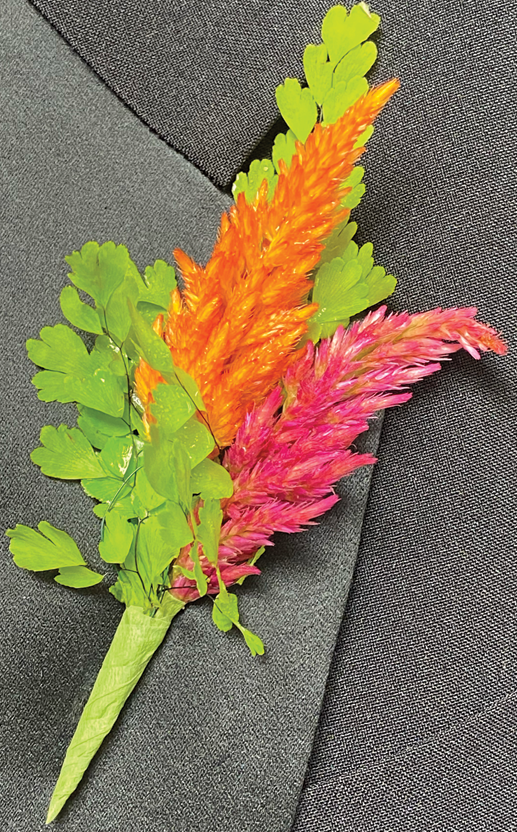
We think that two plumes of Celosia plumosa make a fine boutonniere, especially when paired with maidenhair fern. Hairpin wiring works best with this flower because it gives support to the elongated flower head. The long maidenhair leaves were also hairpin-wired.
Hand-tied Bouquet
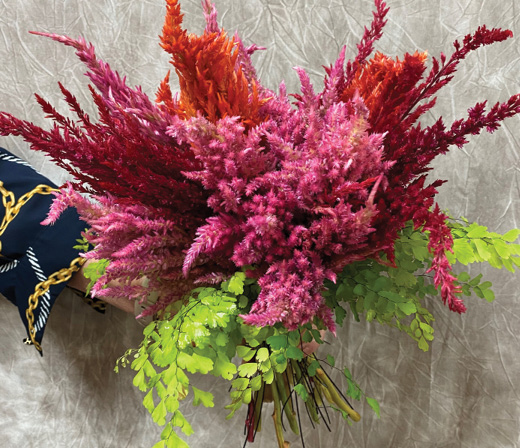
Warm-colored Celosia plumosa flowers contrast well with yellow-green maidenhair fern (Adiantum raddianum) foliage. We bound the stems with waterproof tape and banded over it with light green ribbon. Fluffy celosia flower heads are fuller than Astilbe, their more expensive and wilt-prone counterpart that many florists love. Celosia’s wild colors will appeal to today’s bride who adores the look of plumes and grasses. Why not take advantage of today’s trends by offering a contemporary look in flowers?
Table Arrangements
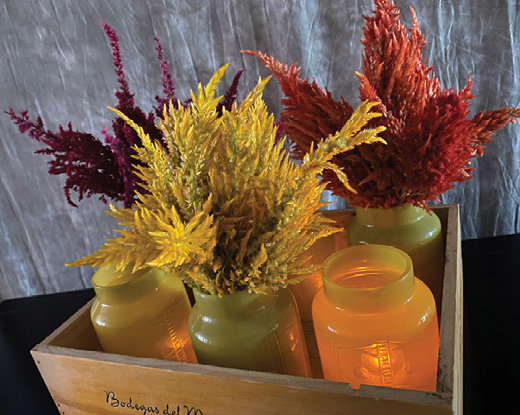
It is often possible to get good buys on glassware at wholesale florists or flea markets. A key to making small containers work as a table centerpiece is to group them. Our matched set of yellow jars, each holding a different color of Celosia plumosa, fit nicely into a wooden wine crate. Using one flower color in each vase makes a stronger statement. Our design is intended as a table centerpiece for an outdoor summertime event that begins before sunset. Twinkling candlelight (battery-operated for safety around plant material) catches the eye at dusk, and the hardy Celosia flowers do not mind the heat of a day-long display during the warm growing season.
Garland
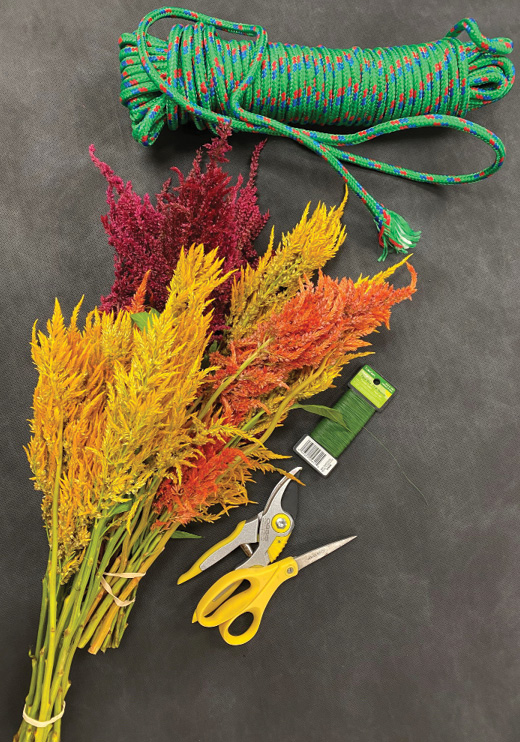
You will need some strong rope and paddle wire for this project. We used rappelling rope, but jute rope works fine. If you use jute string, your design can be fully composted.
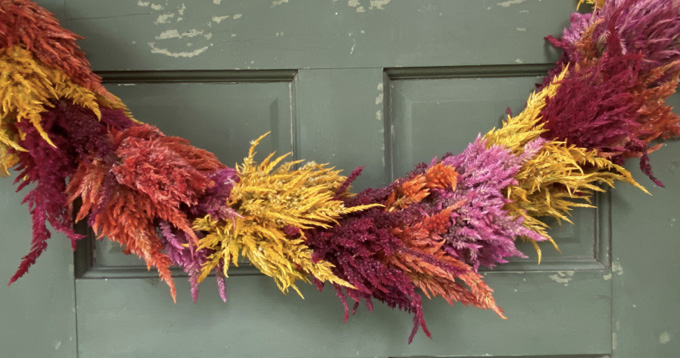
Begin the project by forming a loop with the rappelling rope. Hold it in place with the paddle wire. Add Celosia plumosa placements around the rope, then bind them in place with the paddle wire. Continue this process, alternating flower colors. Add a loop at the end of the garland and wire it in place. Coat the garland with antitranspirant spray. This same design can adorn chair backs, church pews, entrances, or tabletops.
Be sure to price this design by the foot, the same way that professional garland-makers do. This helps you to estimate the cost of the materials and provide accurate retail pricing.
Resources
Armitage, A. M., & Laushman, J. M. (2003). Specialty cut flowers: The production of annuals, perennials, bulbs, and woody plants for fresh and dried cut flowers (2nd ed.). Timber Press.
Byczynski, L. (1997). The flower farmer. Chelsea Green Publishing.
Johnny’s Selected Seeds. (2016, November 3). Celosia production.
Vaughn, M. J. (1988). The complete book of cut flower care. Timber Press.
The authors acknowledge Scott Langlois and the staff of the South Mississippi Branch Experiment Station in Poplarville for their assistance.
The information given here is for educational purposes only. References to commercial products, trade names, or suppliers are made with the understanding that no endorsement is implied and that no discrimination against other products or suppliers is intended.
Publication 3915 (POD-06-23)
By Christine Coker, PhD, Research Professor, Coastal Research and Extension Center; James M. DelPrince, PhD, Associate Extension Professor, Coastal Research and Extension Center; and Patricia Knight, PhD, Director of Coastal Horticulture Research, South Mississippi Branch Experiment Station.
The Mississippi State University Extension Service is working to ensure all web content is accessible to all users. If you need assistance accessing any of our content, please email the webteam or call 662-325-2262.




